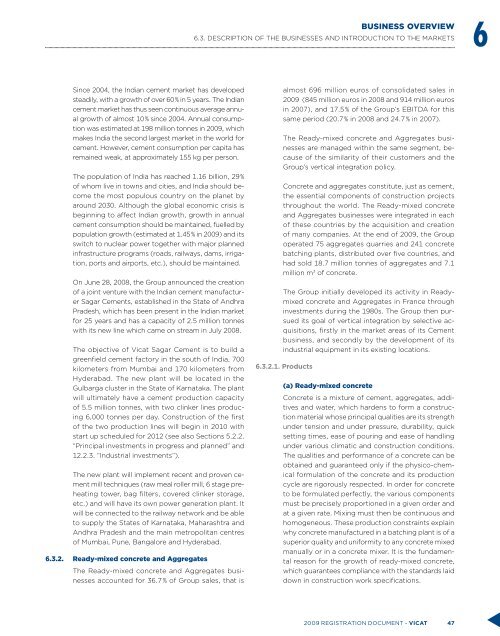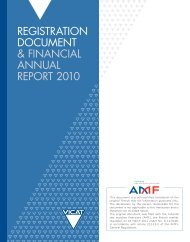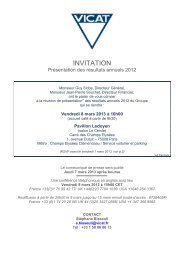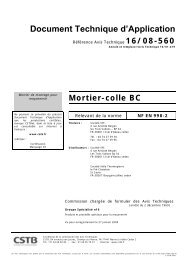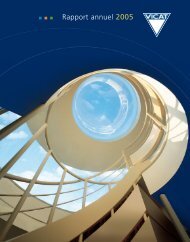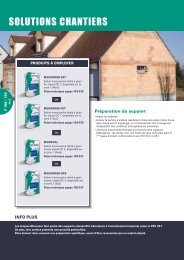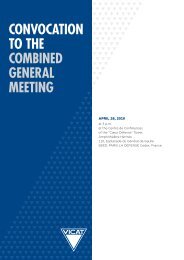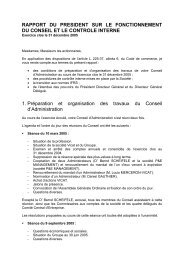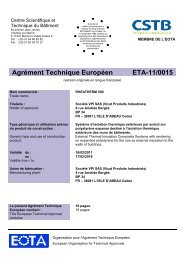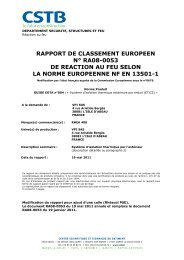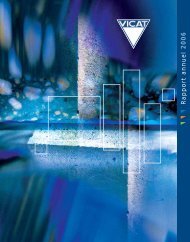6 - Vicat
6 - Vicat
6 - Vicat
- No tags were found...
Create successful ePaper yourself
Turn your PDF publications into a flip-book with our unique Google optimized e-Paper software.
BUSINESS OVERVIEW6.3. DESCRIPTION OF THE BUSINESSES AND INTRODUCTION TO THE MARKETS6Since 2004, the Indian cement market has developedsteadily, with a growth of over 60 % in 5 years. The Indiancement market has thus seen continuous average annualgrowth of almost 10 % since 2004. Annual consumptionwas estimated at 198 million tonnes in 2009, whichmakes India the second largest market in the world forcement. However, cement consumption per capita hasremained weak, at approximately 155 kg per person.The population of India has reached 1.16 billion, 29 %of whom live in towns and cities, and India should becomethe most populous country on the planet byaround 2030. Although the global economic crisis isbeginning to affect Indian growth, growth in annualcement consumption should be maintained, fuelled bypopulation growth (estimated at 1.45 % in 2009) and itsswitch to nuclear power together with major plannedinfrastructure programs (roads, railways, dams, irrigation,ports and airports, etc.), should be maintained.On June 28, 2008, the Group announced the creationof a joint venture with the Indian cement manufacturerSagar Cements, established in the State of AndhraPradesh, which has been present in the Indian marketfor 25 years and has a capacity of 2.5 million tonneswith its new line which came on stream in July 2008.The objective of <strong>Vicat</strong> Sagar Cement is to build agreenfield cement factory in the south of India, 700kilometers from Mumbai and 170 kilometers fromHyderabad. The new plant will be located in theGulbarga cluster in the State of Karnataka. The plantwill ultimately have a cement production capacityof 5.5 million tonnes, with two clinker lines producing6,000 tonnes per day. Construction of the firstof the two production lines will begin in 2010 withstart up scheduled for 2012 (see also Sections 5.2.2.“Principal investments in progress and planned” and12.2.3. “Industrial investments”).The new plant will implement recent and proven cementmill techniques (raw meal roller mill, 6 stage preheatingtower, bag filters, covered clinker storage,etc.) and will have its own power generation plant. Itwill be connected to the railway network and be ableto supply the States of Karnataka, Maharashtra andAndhra Pradesh and the main metropolitan centresof Mumbai, Pune, Bangalore and Hyderabad.6.3.2. Ready-mixed concrete and AggregatesThe Ready-mixed concrete and Aggregates businessesaccounted for 36.7 % of Group sales, that isalmost 696 million euros of consolidated sales in2009 (845 million euros in 2008 and 914 million eurosin 2007), and 17.5 % of the Group’s EBITDA for thissame period (20.7 % in 2008 and 24.7 % in 2007).The Ready-mixed concrete and Aggregates businessesare managed within the same segment, becauseof the similarity of their customers and theGroup’s vertical integration policy.Concrete and aggregates constitute, just as cement,the essential components of construction projectsthroughout the world. The Ready-mixed concreteand Aggregates businesses were integrated in eachof these countries by the acquisition and creationof many companies. At the end of 2009, the Groupoperated 75 aggregates quarries and 241 concretebatching plants, distributed over five countries, andhad sold 18.7 million tonnes of aggregates and 7.1million m 3 of concrete.The Group initially developed its activity in Readymixedconcrete and Aggregates in France throughinvestments during the 1980s. The Group then pursuedits goal of vertical integration by selective acquisitions,firstly in the market areas of its Cementbusiness, and secondly by the development of itsindustrial equipment in its existing locations.6.3.2.1. Products(a) Ready-mixed concreteConcrete is a mixture of cement, aggregates, additivesand water, which hardens to form a constructionmaterial whose principal qualities are its strengthunder tension and under pressure, durability, quicksetting times, ease of pouring and ease of handlingunder various climatic and construction conditions.The qualities and performance of a concrete can beobtained and guaranteed only if the physico-chemicalformulation of the concrete and its productioncycle are rigorously respected. In order for concreteto be formulated perfectly, the various componentsmust be precisely proportioned in a given order andat a given rate. Mixing must then be continuous andhomogeneous. These production constraints explainwhy concrete manufactured in a batching plant is of asuperior quality and uniformity to any concrete mixedmanually or in a concrete mixer. It is the fundamentalreason for the growth of ready-mixed concrete,which guarantees compliance with the standards laiddown in construction work specifications.2009 registration document - VICAT 47


